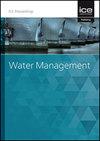Performance comparison of deep learning models to extract silt storage dams in remote sensing images to prevent water loss and soil erosion
IF 0.9
4区 工程技术
Q3 ENGINEERING, CIVIL
Proceedings of the Institution of Civil Engineers-Water Management
Pub Date : 2023-11-10
DOI:10.1680/jwama.22.00094
引用次数: 0
Abstract
Determining the locations and shapes of silt storage dams (SSDs) is necessary before planning and constructing new ones or maintaining old ones. Google images with a spatial resolution of 0.54 m were cropped, labelled and enhanced to establish two schemes of remote sensing images that contain SSDs with different input and batch sizes. Five deep learning models (FCN (fully connected convolutional neural network, SegNet (deep convolutional encoder–decoder architecture for image segmentation), U-Net (convolutional networks for biomedical image segmentation), PSPNet (pyramid scene parsing network) and DeepLab-V3+) were constructed to extract SSDs from the images based on the two schemes. The loss curves, accuracies and extraction results derived from the five models were compared to identify the optimal model for SSD extraction. The results show that the overall accuracies, F 1 scores and mean intersections over unions obtained from DeepLab-V3+ were, respectively, 95.29%, 70.33% and 74.13% for scheme 1 (S1) and 96.29%, 73.34% and 76.99% for scheme 2 (S2), which were better than the values for other models. PSPNet had the shortest training times (128 s/step for S1 and 348 s/step for S2). An input size of 480 × 480 pixels, a batch size of 4 and 2304 images enhanced the extraction accuracy and prevented overfitting. The results provide a reference for the planning, construction and maintenance of water and soil conservation measures.深度学习模型在遥感影像中提取泥沙坝防止水土流失的性能比较
在规划和建造新水坝或维修旧水坝之前,必须先确定泥沙贮存坝的位置和形状。对空间分辨率为0.54 m的Google图像进行裁剪、标记和增强,建立了包含不同输入和批量大小ssd的两种遥感图像方案。基于这两种方案构建了FCN(全连接卷积神经网络)、SegNet(用于图像分割的深度卷积编码器-解码器架构)、U-Net(用于生物医学图像分割的卷积网络)、PSPNet(金字塔场景解析网络)和DeepLab-V3+ 5个深度学习模型,从图像中提取ssd。比较了5种模型的损失曲线、准确度和提取结果,确定了SSD提取的最佳模型。结果表明,方案1 (S1)和方案2 (S2)的总体精度、f1分数和平均相交次数分别为95.29%、70.33%和74.13%和96.29%、73.34%和76.99%,优于其他模型。PSPNet的训练时间最短(S1为128 s/步,S2为348 s/步)。输入大小为480 × 480像素,批处理大小为4和2304张图像,提高了提取精度并防止了过拟合。研究结果可为水土保持措施的规划、建设和维护提供参考。
本文章由计算机程序翻译,如有差异,请以英文原文为准。
求助全文
约1分钟内获得全文
求助全文
来源期刊
CiteScore
2.10
自引率
0.00%
发文量
28
审稿时长
6-12 weeks
期刊介绍:
Water Management publishes papers on all aspects of water treatment, water supply, river, wetland and catchment management, inland waterways and urban regeneration.
Topics covered: applied fluid dynamics and water (including supply, treatment and sewerage) and river engineering; together with the increasingly important fields of wetland and catchment management, groundwater and contaminated land, waterfront development and urban regeneration. The scope also covers hydroinformatics tools, risk and uncertainty methods, as well as environmental, social and economic issues relating to sustainable development.

 求助内容:
求助内容: 应助结果提醒方式:
应助结果提醒方式:


